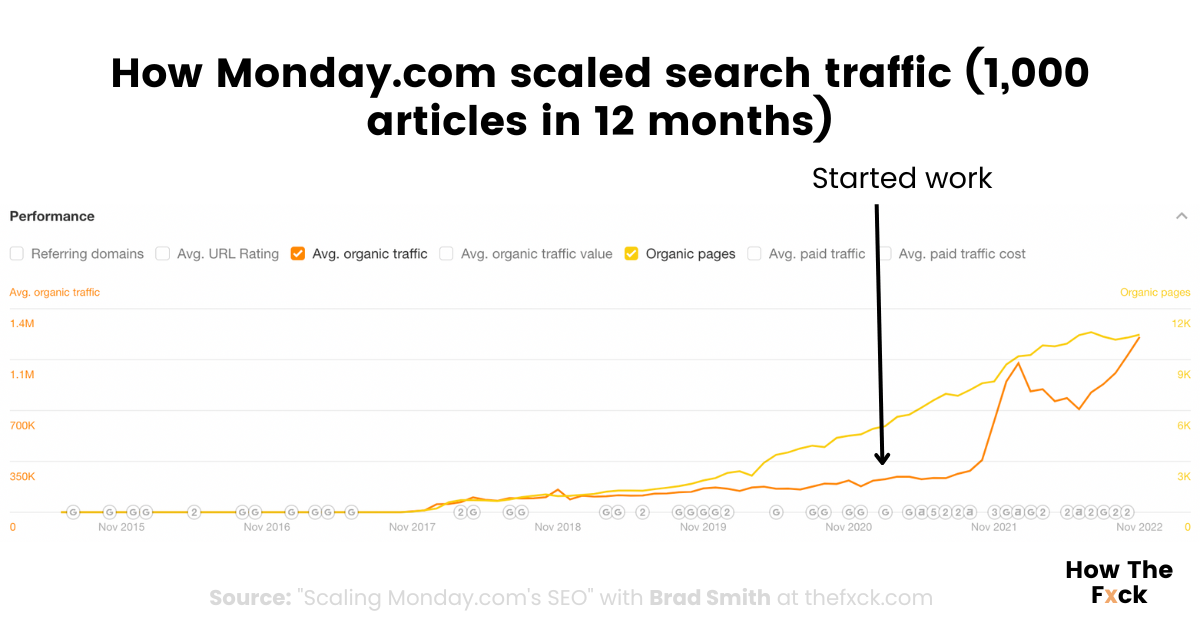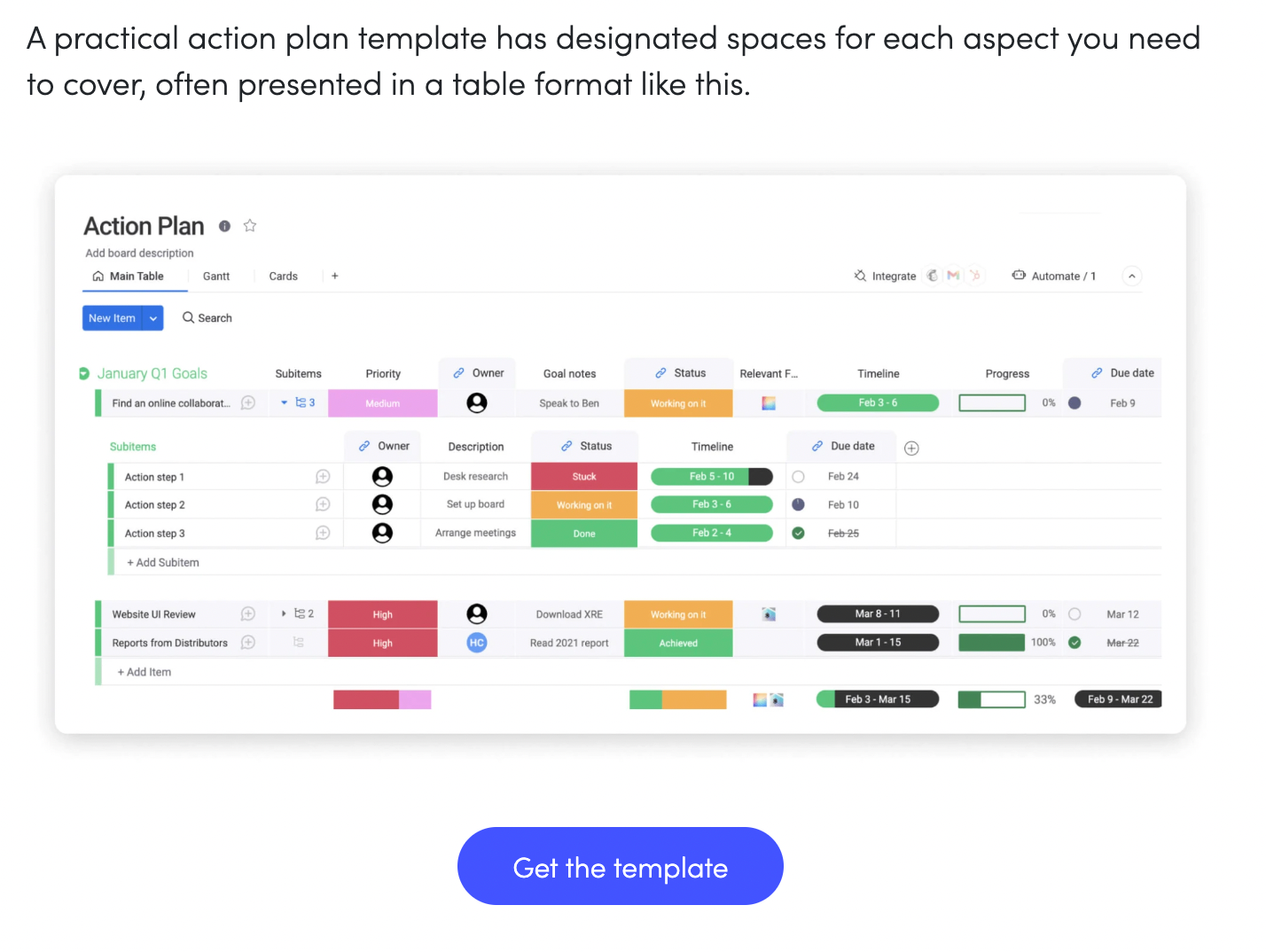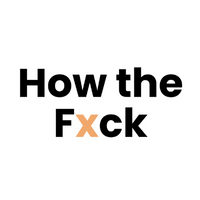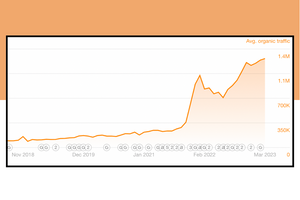In this week's SEO case study, we revisit a story we released in December 2022: How Monday.com Scaled its SEO (1,000 articles in 12 months).
In part one, we looked at the content operation that underpinned Monday's very first major investment into SEO.
We learned how Monday worked with an agency to make up for lost time.
They created over 100 articles a month, scaling to up to 1 million monthly clicks between late 2020 and late 2021.

Expect to hear Monday.com insider secrets in this article.
In part two of the story, we heard from two Monday insiders:
- Eliana Atia, Brand and SEO Content Team Lead, who joined the team just after the IPO, 6 months after the project started.
- Zoe Averbuch, Senior SEO Manager, who led the project while it unfolded.
Eliana and Zoe told us the logic behind the strategy; the return on investment for Monday; and how they've since iterated their strategy.
"It took some time for SEO to really reap the rewards of that initial investment. But we've been given a lot of internal autonomy as a team and the results have been really amazing. I know content is expensive but when you compare content to bidding and running ads it pales in comparison."—Zoe Averbuch, Senior SEO Manager
Expect to learn:
⚡ Monday's SEO philosophy: Why failing fast, learning, and iterating were all part of the plan.
⚡ Working with the paid acquisition team: How Monday's 8 years of heavy ad spend helped optimize their SEO strategy.
⚡ Why prioritization is everything in SEO. And why this means it's important to ship new content before it's fully edited.
⚡ Return on investment: Was the experiment worth it? How has Monday's SEO strategy iterated from their learnings?
⚡ Moving forward: What were their biggest learnings and how are they continuously maintaining their enormous content library?
Monday’s SEO backstory - Why the investment in new content was fast and furious
When the Monday team kicked off their ambitious SEO scale-up about ½ a year before IPO, they had only a small SEO team but had never invested in it as a serious channel for growth.
“So actually Monday has a really interesting story that I think is well known, but in the beginning years, the main focus for marketing and bringing in new leads was through paid acquisition, through Google Ads and other platforms, and SEO and the Organic Channel was basically a one-man show.“—Zoe Averbuch, Senior SEO Manager
So, when Rotem, Monday.com’s then Head of Acquisition of 8 years, decided this was an experiment they needed to invest in properly, they had a lot of making up to do to bring their content in line with industry comparables.
This explains their heavy investment (1,000 articles in 12 months) in a short space of time.
One of my interviewees today, Zoe Averbuch, led the project together with the Codeless.io content product agency
“The head of acquisitions mindset was to just go big or go home. And that's really what you saw, and Codeless helped us with all of the blogs that we did.
I was two months into my time here Monday. And I had the awesome task of onboarding Codeless and working with Rotem to decide we are going to publish content on these keywords. This really wouldn’t have been possible without Monday, without all of the processes that we were able to build. And that's what really helped us scale from little to no content to all these blogs that happened in the span of a few months.”—Zoe Averbuch, Senior SEO Manager
My other interviewee for this podcast, Eliana Atia, joined Monday at a similar time and now leads the team that oversees the content and optimization efforts.
She notes the change as Monday made SEO a strategic priority:
“We had an internal SEO team, but I don't think it really had the internal kind of push and strategic outlook and ambitious goals. I think that's really when it flipped from, you know, we have people focusing on SEO to now we have an SEO team and now we're really building a foundation of our kind of topic authority. We're building out what kind of content we wanna create, how we wanna create it. We’re really building out the blog as kind of a serious endeavor. I think that was when that switch really happened. “—Eliana Atia, Brand and SEO Content Team Lead
Eliana also noted that it was a challenge because their internal team wasn’t necessarily long-term SEO experts. This was a learning experience and an insights-driven one, as we’ll learn later.
But, they each came with their own relevant experience of what makes content great and what makes a customer convert. That was enough to get them started:
“The SEO team doesn't come with years and years and years of experience in SEO. We each came really with, uh, our own relevant experience that we had to apply to SEO, which I think has given us a really unique perspective.”- Eliana Atia, Brand and SEO Content Team Lead
How the Monday team decided which keywords to win
I asked the Monday SEO team how they approached topic clustering and choosing keywords to go after.
They noted that for this project they were very data-led. They were clear on who their target audiences were and what topics they were interested in thanks to their Google Ads data.
“Even though Monday offers a broad range of solutions for different markets, we had to first start with our baby, for lack of a better word, which is our project management solution. And that was where we really played catch up.
Previously, before the establishment of the team, we focused on lower volume, lower traffic keywords. Really just doing the low-hanging fruit. So we ended up ranking on the first page for less valuable keywords, which were for example “management books”.
These keywords were less related to “project management”, [which is the topic areas we really wanted to win.]
We decided to go after these new keywords based on the vast data that we had from Google Ads and all of the acquisition team’s work, which has been running ads for so many years. We had real data and this was Rotem’s idea. He knew the inside story and how to translate these keywords into bringing us success in SEO”—Zoe Averbuch, Senior SEO Manager
It’s an incredible superpower to have started with paid acquisition channels, learn what works in a quick and iterative way, and then choose to target those topics with SEO.
Their vast amounts of conversion data made it clear that if they won certain keywords, they would receive high conversions from them.
“Regarding the markets and the niches, we really had this data that we were able to just, okay, we're going after the keywords that we know if we are on the first page, we will see the benefits that we're hoping to see.”—Zoe Averbuch, Senior SEO Manager
Monday.com’s Approach to Content Creation: Going hard on what matters most
The Monday team’s approach to content creation is to invest heavily in the stuff they really know is going to convert. And less so in the nice-to-have content—the top-of-funnel stuff created more for brand awareness, email lists, and topical authority building.
Google Ads keywords have a heavy influence over the process.
“The data our Google Ads team was able to provide us told us which pieces we should really, really invest in.”—Eliana Atia, Brand and SEO Content Team Lead
When they know a piece is more important to win, they spend a significant amount more time on it as a team. For example, get the whole team on board to ideate for high-intent pieces.
“Every quarter we've always had kind of the highest intent, uh, for us pieces to focus on. And those are the ones that, you know, internally will meet as a team and. Pull up the piece on a big screen with the whole team and say, let's look at the other first-ranking pieces. Let's look at just from a user, uh, from a user perspective, is there something that's jumping out at you that doesn't feel natural? Is there a place that we can incorporate design or, um, maybe play with the headers?”—Eliana Atia, Brand and SEO Content Team Lead
That doesn’t mean they didn’t create quality, on-brand content across their lower-intent topics. But they didn’t get the full resources thrown at them—prioritization is important when creating so much content.
Example content: Ultimate Guide to Project Management Software
Their ultimate dream was to win “project management software”. It’s high intent and high conversion for Monday and really high volume.
They’re currently in position 2 for the keyword. Here’s how they won it:
Instead of creating a top 10 or top 15 articles, they did ALL of them. Their article has 300 tools listed and categorized in an 18,000-word article.
It made it to page one in one week.
“The point of this article is not to read it from start to finish. Yeah. That's sure's really to use the categories and what you're specifically looking for, be it project management or Kanban, or for specific CRMs, or your specific industry, and then to see go straight to the list within that. [We wanted to create] one resource that you can know as the most up-to-date [place to visit for that topic]”—Zoe Averbuch, Senior SEO Manager
How has their approach to content changed? What have they learned since the first SEO project?
The Monday team has switched to optimizing and updating. Over time they realized that more, more, more new content isn’t always better, but squeezing more conversion out of old content is most effective.
“We learned over time that we can create a piece for every single keyword that we've identified as high intent. However, it's not always the right approach.
So now we're honing on the [existing] clusters and seeing where there are gaps there.
But regarding unique pieces, we found that we're actually spending more time on the pieces that we have already identified as successful and making them even better, updating them with our new features, new designs, and the polls we added to our blogs.
We have [new] tools for engagement that we are focusing on. But we won't tell you all of our secrets.”—Zoe Averbuch, Senior SEO Manager
Zoe mentioned they’ve been implementing new engagement tools in their articles, which had me intrigued.
I couldn’t find much on their top pages. But one thing they have done is started building out templates that align with the topic of each blog.
Their article on RACI models now has an upsell in it: “try monday.com RACI template”. A closely aligned template is a smart way to drive new acquisition from SEO content.
Was their investment all worth it? Could the project have been done more efficiently?
"Like what was it all worth it? Could you have done it more efficiently?"—Me
Eliana and Zoe both gave a firm “yes”. This project has seen a significant ROI.
Not to mention the brand awareness lift from growing 600% traffic in 2 years, they also made a point of mentioning that the traffic was high quality and high converting.
“So the beauty of SEO is that it's unlike an ad, you can stop paying for an ad and you will have no mark left on the internet. But with SEO, all of the work from two years ago, from three years ago, and from yesterday, continues to create an impact and we really had such a gap in our content, especially for a company that was about to go public and has so much knowledge to share.
We were lacking [in content assets]. We had the resources, but we didn't have the content and we had to just create that output. And we did the best we can with what we had.
The traffic was a huge boost. We increased our traffic by over 600% in the last two years.
So the traffic is definitely there, but in all honesty, the traffic, if it's people who are searching and coming to our website for a topic like management books, it's not the best high intent. So [the traffic data alone is meaningless].
However, also the quality of the visits was there thanks to this huge project that we took on. So we're super proud of it. And, now we've really just invested in those pieces even more and it continues to bring the traffic that it did and, and even more.”—Zoe Averbuch, Senior SEO Manager
Now, we have data to learn from.
Eliana tackles my question on efficiency.
She makes a fantastic point: to make good decisions you need data. Significant amounts. Sometimes you have to be inefficient to get data.
This high-scale project gave them just that.
“I can also say like, for sure there's always room to have done something more efficiently.
In retrospect, of course, if we were going back two years we would do things differently. I can say when I first joined the SEO team, which I believe was right after IPO, Zoe was on the team a bit longer than I was, and, Rotem was walking me through all of the strategy and everything we were doing.
And I got so excited and I was like, right, we can start optimizing every page and running tests on what is converting and what is not. And he kind of said like, whoa, whoa, whoa. Slow your horses. First, we need to get eyeballs on the blog then we'll iterate and then we'll understand. Before we have numbers, before we have traffic, it's not data.
You can't really pull insights from it until we have traffic in the thousands and thousands and thousands. And that really, really stuck with me.”—Eliana Atia, Brand and SEO Content Team Lead
Before you can be smarter and more considered, you need to experiment and learn. From this mindset alone you can see growth marketing’s influence over the content team.
Ship. Move fast. Learn. Iterate. It’s the Monday.com philosophy and it’s led to a point where they can double down on high conversion rate pieces.
“Just from the perspective of before we can be smarter, we need to have a data set that we can work with. And that I think is really a way to look at, you know, the first year of SEO was bringing traffic that is in some way relevant to us. And then once we have those people and data, now we're really doubling down on those high-intent pieces.”—Eliana Atia, Brand and SEO Content Team Lead
And they're also working on optimizing their lower content to squeeze more juice out of it by implementing downloads and nurture flows.
“And also internally as a team, just even last quarter and this quarter, we're focusing even on, okay, we still have traffic for these lower intent pieces, maybe, “project management methodologies”. They're not an irrelevant audience, but they're a little higher in the funnel. So what are ways that we can really capitalize on these people that are visiting our blog?
But not quite ready necessarily to sign up. So we're looking into nurture flows and email newsletters and things like that we can really kind of warm-up those audiences. So I think we see really SEO as a long-term investment. It's not just another kind of acquisition channel, it's also a brand opportunity.
It's a way for people to meet our brand and learn about our product and learn about our company. I see SEO as multi-pronged”—Eliana Atia, Brand and SEO Content Team Lead
Growth is a learning curve at Monday.com
I really like that this has been part of their philosophy from the start. It explains how they grew so fast—hustle.
“That's something that Monday really believes in. It's about execution and learning and optimizing as soon as you have a most viable product. You just go with it. So yeah, it wasn't perfect and it's a muscle we’ve exercised a lot since then. We ended up with a lot of duplicate content and keywords that were competing with each other. We definitely learned.”—Zoe Averbuch, Senior SEO Manager
Ad budget vs SEO budget - It "paled in comparison"
It’s worth noting the difference in expenses when this question arises.
Monday is a company well-known for its advertising—it’s pretty hard to miss it.
Zoe and Eliana noted in the interview that the budget paled in comparison to what they were spending on acquisition. So it wasn’t that challenging to get buy-in and investment for it.
When you’re spending £20 a click on the keyword “project management software”, spending £5000 on an article to rank #2 and get the clicks for free is a no-brainer.
“It took some time for SEO to really reap the rewards of that initial investment. But we've been given a lot of internal autonomy as a team and the results have been really amazing”—Eliana Atia, Brand and SEO Content Team Lead
Zoe weighs in:
“I will add that from a company perspective, most of the new leads were coming from the acquisition team and adverts.
So when you compare, I know content is expensive but when you compare content to bidding and running ads it pales in comparison. Yeah. So, when you compare it to the budget for acquisition it was an easy win in that sense.
It was really the fact when you compare the two and you're able to show, okay, this is how much it costs for an ad and this is how much a blog post costs for the same keyword, and we will optimize it and hopefully, we have to just try get to the first page, uh, and it will stay there and the ad will go away. And we have to pay for the ad continuously. So when you compare it's a pretty easy sell.”—Zoe Averbuch, Senior SEO Manager
Zoe finished with an interesting point:
“For a company that's been focusing for so long on ads. When you're opening up an organic channel, it's much easier than doing the opposite, than changing your mindset from just organic to ads.”—Zoe Averbuch, Senior SEO Manager
How can you make content more affordable to scale?
This question comes from a How the F*ck listeners question: “Any tips for doing content production in a more affordable way?”
Zoe made these four points:
- Be really clear in the content brief about what you want from the writer, so less editing work needs to be done to get a high-quality article.
- Be really clear about who your audience is and how to position your message and product in your content.
- Be really clear you haven’t already got a piece of content on that topic. They note that they accidentally made the same pieces or cannibalized content multiple times.
- Squeeze more from content: If you have a small budget, focus on making one really really good piece that ranks for many different keywords.
“Google wants the good content that’s gonna be valuable for the readers. So it's not about just getting a hundred blogs for the sake of saying, oh, we publish a hundred blogs.
One blog can be enough and it can do a much greater impact. So don't be scared. Go after the higher traffic, the ones that will really bring in the audience that you're looking for. And I think that's an affordable way to start at least with your SEO strategy.”—Zoe Averbuch, Senior SEO Manager
The Monday team's big learnings from building their SEO strategy
1. Workflow efficiencies: Our biggest learning during this process
One of their biggest learnings from building a professional SEO team was that, at this scale, inefficiencies really show. Processes and workflows are critically important (we learn all about the content production workflows in place from the Codeless team here).
“I think it, it all touches sort of on a theme that has definitely been a huge learning for us. Workflow efficiencies. You see it more when you're working at the scale that we're working in, but exactly as Zoe said, the briefs, the editing, whether it's with freelancers or an agency, your editing team or content team, making sure that the deadlines are really clear.
These small hiccups can come up throughout the duration of a quarter. A few of them really combined to be something and I think that's a huge learning that we've taken away over the quarters.
Every single quarter we do retros and we understand the things that were working that weren't working, how our communication internally is going, if there were elements of the workflow that weren't helpful for the team or that created, you know, maybe excess work that we can cut out.
I think there's a huge operational element to SEO that is talked about less."—Eliana Atia, Brand and SEO Content Team Lead
Please check out our guide to content operations here.
2. An experiment that went well—our template strategy
Eliana made note of an experiment that went well: implementing templates.
“I can start maybe with an experiment that went well. One of them that really caught on was our template strategy as we call it.
One quarter we had a meeting, I think it was with our CRO and he threw out an idea like, we have the ability to create templates within Monday, so why don't we try to create a lot of personalized templates? And have that be a strategy.
And we said, okay, that sounds like a good idea.
Very quickly we had one person on the team that was dedicated just to building, researching, and executing these templates within the platform.
Then we mapped out tons of template keywords. We created a guide on how to write these blogs specifically for templates.
I think it's the most successful strategy that [we implemented]."—Eliana Atia, Brand and SEO Content Team Lead
This very much reminds me of Typeform's template strategy, which nets them $3m LTV value each year via SEO.
You can see it in action for Monday here.
The article includes a template and a CTA. Instead of a download, you sign up and start using the template within the Monday.com platform.

This of course drives the new acquisition of users.
How does Monday do content updates?
When you've created 1,000 articles in 12 months, the question remains: how do you maintain, optimize and update that library continuously?
The lessons shared by Zoe and Eliana were illuminating and key to understanding their approach to content.
Ship it first, edit it later
They ship new content before it's perfect and optimized according to their brand standards. When it starts ranking, they get notified and only then apply their editorial process.
“Everything that we do is based on priorities. So let's say we have a new piece of content that's been created that hasn't been edited yet, or optimized according to our standards, it's gonna be hidden from /blog/ until it is ranking [and] we see that it's actually gaining traction and ranking on Google.
And then it'll be sort of flagged for us and we say, okay, now this is actually gaining traffic. It's not just in the dusty corners of the internet somewhere. Now we need to take a look at it, and make sure that it's up to our standards.—Eliana Atia, Brand and SEO Content Team Lead
This allows the Monday team to produce so much content while staying efficient. Not everything goes live on the blog for existing customers and prospects to see.
But they also want to get content indexed by Google ASAP. This process bridges that gap.
“So it's basically how we manage creating so, so, so, so many pieces of new content. Yeah, everything is through the lens of priority. We only have so many internal resources. We only have so many people on the team and they have a lot of different focus areas. So basically before a piece is live on the blog, it goes through editing rounds but it might not be 100% perfect. But we wanna get it live on WordPress as soon as possible, just so Google can start indexing it."
"And there's really no point in investing three, four hours in a blog that may never rank and is gonna be on the 12th page of our project management blog internally. It's not the best use of our time. We can be allocating those hours to a piece. Let's say that's ranking six position and let's take it to first position."
You know, my manager always says, is the juice worth the squeeze?—Eliana Atia, Brand and SEO Content Team Lead
Avoid perfectionism with your content
Eliana notes that they keep track of all content that's out there but not perfect. But shipping it before being perfect is an important part of their growth.
“It's not intuitive to just say let's just get it out. And I think that's kind of when the workflow and being detail-oriented comes into play. Because I've had conversations with my team, I think it's normal for content writers to be sort of perfectionists a little bit. And they'll say like, sometimes I just think about how many pieces are out there that aren't perfect, and it's like, no, each and every one of them is marked. We know the last time we touched it, we know like it's, it's organized. Um, and as long as it doesn't get out of control, I think it's, uh, really the smartest way to approach it.”—Eliana Atia, Brand and SEO Content Team Lead
What kind of things do they add to the content in their update process?
“We are constantly, constantly, optimizing and updating.
I mean from just obvious systematic things like the turn of the new year. You know, we wanna go in and update any pieces that are 2022 to 2023 and make sure that the content within that piece is updated and we're not referencing studies from 2022 or 2021 when it's now the new year.
So anything from that to constantly monitoring which pieces are ranking on the first page, when was the last time they were optimized, and also thinking differently about how we're optimizing things.
[We make sure] it's well written and the content passes our expectations, but also, what kind of additional elements can we involve? You mentioned video. We have a lot of amazing kind of video resources. We have a podcast, like what else can we really include to enrich these pieces?”—Eliana Atia, Brand and SEO Content Team Lead


